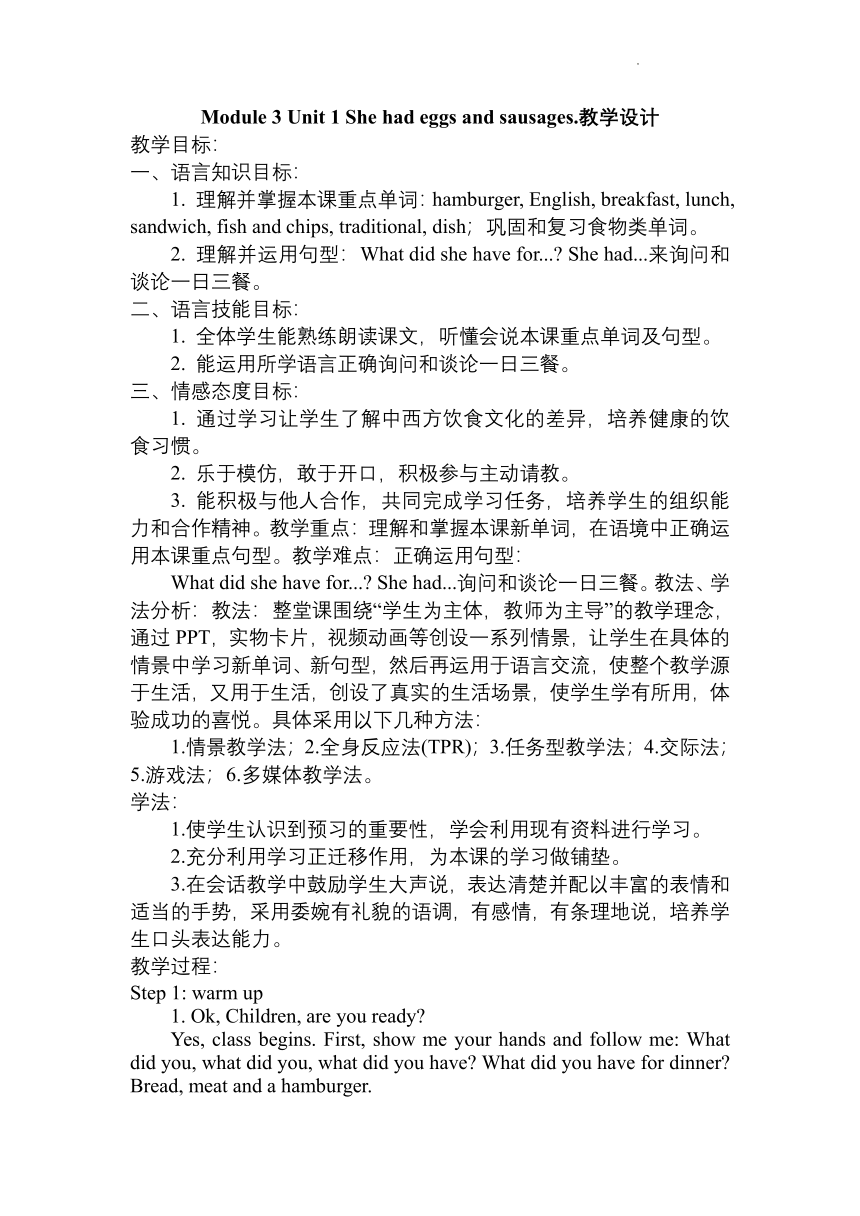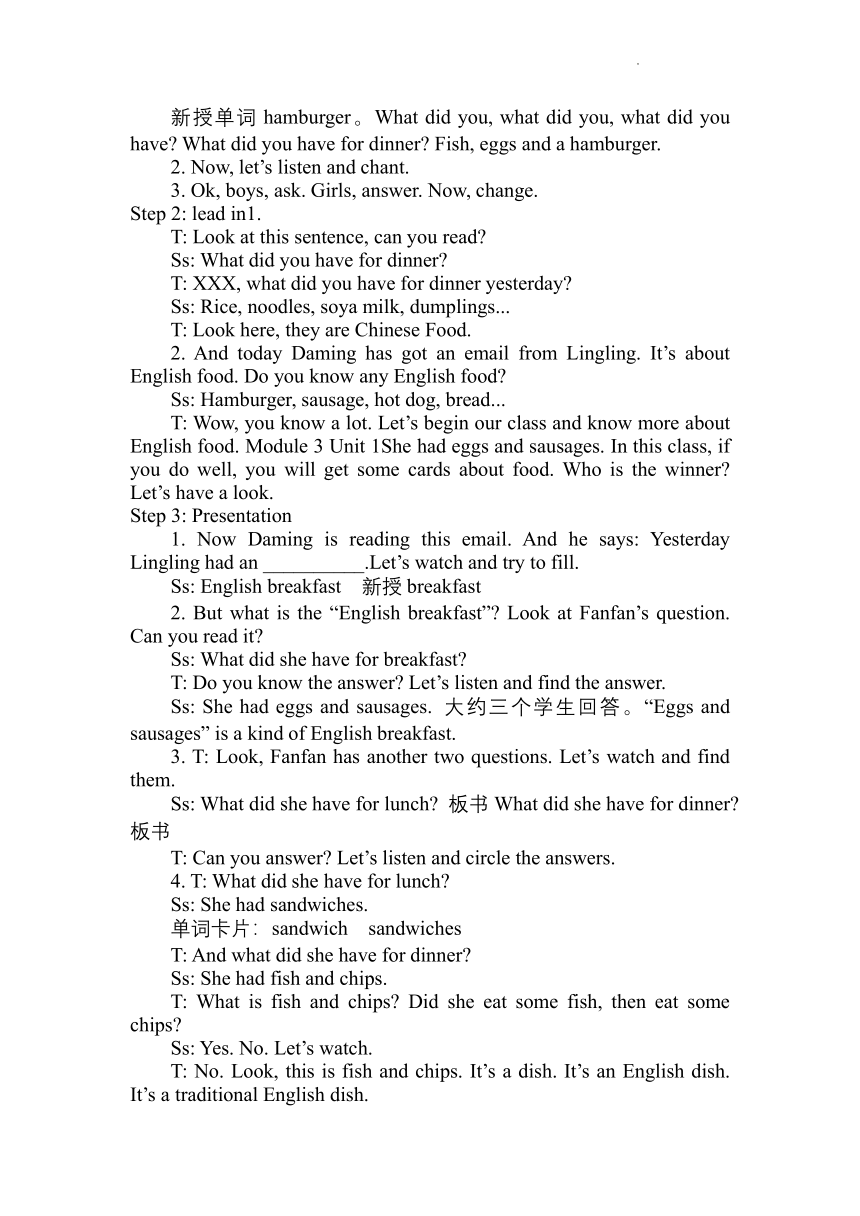Module 3 Unit 1 She had eggs and sausages 教案
文档属性
| 名称 | Module 3 Unit 1 She had eggs and sausages 教案 |  | |
| 格式 | zip | ||
| 文件大小 | 33.7KB | ||
| 资源类型 | 教案 | ||
| 版本资源 | 外研版(三年级起点) | ||
| 科目 | 英语 | ||
| 更新时间 | 2022-05-21 15:18:31 | ||
图片预览


文档简介
Module 3 Unit 1 She had eggs and sausages.教学设计
教学目标:
一、语言知识目标:
1. 理解并掌握本课重点单词:hamburger, English, breakfast, lunch, sandwich, fish and chips, traditional, dish;巩固和复习食物类单词。
2. 理解并运用句型:What did she have for... She had...来询问和谈论一日三餐。
二、语言技能目标:
1. 全体学生能熟练朗读课文,听懂会说本课重点单词及句型。
2. 能运用所学语言正确询问和谈论一日三餐。
三、情感态度目标:
1. 通过学习让学生了解中西方饮食文化的差异,培养健康的饮食习惯。
2. 乐于模仿,敢于开口,积极参与主动请教。
3. 能积极与他人合作,共同完成学习任务,培养学生的组织能力和合作精神。教学重点:理解和掌握本课新单词,在语境中正确运用本课重点句型。教学难点:正确运用句型:
What did she have for... She had...询问和谈论一日三餐。教法、学法分析:教法:整堂课围绕“学生为主体,教师为主导”的教学理念,通过PPT,实物卡片,视频动画等创设一系列情景,让学生在具体的情景中学习新单词、新句型,然后再运用于语言交流,使整个教学源于生活,又用于生活,创设了真实的生活场景,使学生学有所用,体验成功的喜悦。具体采用以下几种方法:
1.情景教学法;2.全身反应法(TPR);3.任务型教学法;4.交际法;5.游戏法;6.多媒体教学法。
学法:
1.使学生认识到预习的重要性,学会利用现有资料进行学习。
2.充分利用学习正迁移作用,为本课的学习做铺垫。
3.在会话教学中鼓励学生大声说,表达清楚并配以丰富的表情和适当的手势,采用委婉有礼貌的语调,有感情,有条理地说,培养学生口头表达能力。
教学过程:
Step 1: warm up
1. Ok, Children, are you ready
Yes, class begins. First, show me your hands and follow me: What did you, what did you, what did you have What did you have for dinner Bread, meat and a hamburger.
新授单词hamburger。What did you, what did you, what did you have What did you have for dinner Fish, eggs and a hamburger.
2. Now, let’s listen and chant.
3. Ok, boys, ask. Girls, answer. Now, change.
Step 2: lead in1.
T: Look at this sentence, can you read
Ss: What did you have for dinner
T: XXX, what did you have for dinner yesterday
Ss: Rice, noodles, soya milk, dumplings...
T: Look here, they are Chinese Food.
2. And today Daming has got an email from Lingling. It’s about English food. Do you know any English food
Ss: Hamburger, sausage, hot dog, bread...
T: Wow, you know a lot. Let’s begin our class and know more about English food. Module 3 Unit 1She had eggs and sausages. In this class, if you do well, you will get some cards about food. Who is the winner Let’s have a look.
Step 3: Presentation
1. Now Daming is reading this email. And he says: Yesterday Lingling had an __________.Let’s watch and try to fill.
Ss: English breakfast 新授breakfast
2. But what is the “English breakfast” Look at Fanfan’s question. Can you read it
Ss: What did she have for breakfast
T: Do you know the answer Let’s listen and find the answer.
Ss: She had eggs and sausages. 大约三个学生回答。“Eggs and sausages” is a kind of English breakfast.
3. T: Look, Fanfan has another two questions. Let’s watch and find them.
Ss: What did she have for lunch 板书What did she have for dinner 板书
T: Can you answer Let’s listen and circle the answers.
4. T: What did she have for lunch
Ss: She had sandwiches.
单词卡片:sandwich sandwiches
T: And what did she have for dinner
Ss: She had fish and chips.
T: What is fish and chips Did she eat some fish, then eat some chips
Ss: Yes. No. Let’s watch.
T: No. Look, this is fish and chips. It’s a dish. It’s an English dish. It’s a traditional English dish.
5. Yesterday, Lingling had eggs and sausages for breakfast. She had sandwiches for lunch. She had fish and chips for dinner. They are English food. Does Lingling like them
Ss: Yes, she does. She says it’s delicious.
6. Now, take out your book, Let’s listen and imitate.
7. Read the text with your partner.
8. Let’s act it out. 利用板书内容进行对话练习。
9. They are Chinese food. They are English food. We also have some food: vegetables, meat, milk...They are Chinese food and also English food.
Step 4: Practice
1. Now, let me look at your cards. How many cards have you got Oh, you are the e here, please. I need your help. Look, there are so many kinds of food.
T: S1 what did you have for breakfast yesterday
S1:...You can stick it on the blackboard.
T: Now, let’s ask together. What did you have for lunch
S1:...T: Now, let’s ask. What did you have for dinner
S1:...2. Ok, I’ll find another student.
S2 come here, please. Now, who can ask
3. Look at the blackboard, what did S1 have
Ss: She/ He had ... for...
T: Is it good for us
Ss: Yes.
T: What did S1 have What did S2 have
T: Who is better
Ss: S1.
T: ... is not good for us.4. Look children, some food like vegetables, fruit, milk...They’re good for us. But some food like sausages, hamburgers, chips... They’re bad for us. So I think S1 is the “healthy star”.
Step 4: consolidation
Now children, take out your paper. Let’s do a survey. Maybe you can use these sentences: What did you have for... I had...Finish your paper, then find the “healthy star” in your group.
Step 5: Homework
1. Tell your parents about our “Healthy Star”.
2. Make a healthy diet for your family.
Step 6: Blackboard Design
Module 3 Unit 1 She had eggs and sausages.
English Food Chinese Food
breakfast
What did she have for lunch She had
dinner
Module 3 Unit 1 She had eggs and sausages.课后反思
本课的重点是通过运用句:What did she have for... She had...学习对一日三餐吃什么进行提问,并做出相应的回答。针对这节课的教学目标,教学重难点,和学生的实际,我精心地设计了本课的教学内容。首先我利用chant热身,并通过Free talk的形式,引导学生说出理解和说出昨天晚上吃了什么,接着我导入本课的话题Lingling给Daming 发来一封关于英国食物的电子邮件,引出English Food这一话题并导入新课。在课文教学中,我让学生分三段观看课文动画,第一段补全句子学习English breakfast,再通过听录音寻找第一个问题的答案;第二段自主发现Fanfan的两个问题,并通过听录音解决这两个问题;第三段看动画了解Fish and chips 这一传统英国食物。以Fanfan的问题为主线步步推进,先由教师引导学习再由学生自主发现和解决问题。跟读环节,利用点读笔让学生模仿录音中的语音语调,纠正不正确的读音。在句型操练方面,我也采用先由教师示范,再由学生自主展开调查的方式:先一起调查两个同学昨日的一日三餐,评选健康之星,渗透健康饮食教育。有了这一部分做基础,再让学生从组内展开调查,展示和汇报调查结果。
这节课也存在很多不足之处,如,在进行教学设计时虽然考虑到了学生的主体地位,但在实际教学中学生的主体地位体现的不够充分,学生基本上是在我一步步的引导下达成本节课的教学目标,教师预设的过多,课堂上生成的不够。在英语课堂上,我们应给予学生更大的空间展示自我,这样才能更有利于帮助学生逐步形成语言运用能力。
教学目标:
一、语言知识目标:
1. 理解并掌握本课重点单词:hamburger, English, breakfast, lunch, sandwich, fish and chips, traditional, dish;巩固和复习食物类单词。
2. 理解并运用句型:What did she have for... She had...来询问和谈论一日三餐。
二、语言技能目标:
1. 全体学生能熟练朗读课文,听懂会说本课重点单词及句型。
2. 能运用所学语言正确询问和谈论一日三餐。
三、情感态度目标:
1. 通过学习让学生了解中西方饮食文化的差异,培养健康的饮食习惯。
2. 乐于模仿,敢于开口,积极参与主动请教。
3. 能积极与他人合作,共同完成学习任务,培养学生的组织能力和合作精神。教学重点:理解和掌握本课新单词,在语境中正确运用本课重点句型。教学难点:正确运用句型:
What did she have for... She had...询问和谈论一日三餐。教法、学法分析:教法:整堂课围绕“学生为主体,教师为主导”的教学理念,通过PPT,实物卡片,视频动画等创设一系列情景,让学生在具体的情景中学习新单词、新句型,然后再运用于语言交流,使整个教学源于生活,又用于生活,创设了真实的生活场景,使学生学有所用,体验成功的喜悦。具体采用以下几种方法:
1.情景教学法;2.全身反应法(TPR);3.任务型教学法;4.交际法;5.游戏法;6.多媒体教学法。
学法:
1.使学生认识到预习的重要性,学会利用现有资料进行学习。
2.充分利用学习正迁移作用,为本课的学习做铺垫。
3.在会话教学中鼓励学生大声说,表达清楚并配以丰富的表情和适当的手势,采用委婉有礼貌的语调,有感情,有条理地说,培养学生口头表达能力。
教学过程:
Step 1: warm up
1. Ok, Children, are you ready
Yes, class begins. First, show me your hands and follow me: What did you, what did you, what did you have What did you have for dinner Bread, meat and a hamburger.
新授单词hamburger。What did you, what did you, what did you have What did you have for dinner Fish, eggs and a hamburger.
2. Now, let’s listen and chant.
3. Ok, boys, ask. Girls, answer. Now, change.
Step 2: lead in1.
T: Look at this sentence, can you read
Ss: What did you have for dinner
T: XXX, what did you have for dinner yesterday
Ss: Rice, noodles, soya milk, dumplings...
T: Look here, they are Chinese Food.
2. And today Daming has got an email from Lingling. It’s about English food. Do you know any English food
Ss: Hamburger, sausage, hot dog, bread...
T: Wow, you know a lot. Let’s begin our class and know more about English food. Module 3 Unit 1She had eggs and sausages. In this class, if you do well, you will get some cards about food. Who is the winner Let’s have a look.
Step 3: Presentation
1. Now Daming is reading this email. And he says: Yesterday Lingling had an __________.Let’s watch and try to fill.
Ss: English breakfast 新授breakfast
2. But what is the “English breakfast” Look at Fanfan’s question. Can you read it
Ss: What did she have for breakfast
T: Do you know the answer Let’s listen and find the answer.
Ss: She had eggs and sausages. 大约三个学生回答。“Eggs and sausages” is a kind of English breakfast.
3. T: Look, Fanfan has another two questions. Let’s watch and find them.
Ss: What did she have for lunch 板书What did she have for dinner 板书
T: Can you answer Let’s listen and circle the answers.
4. T: What did she have for lunch
Ss: She had sandwiches.
单词卡片:sandwich sandwiches
T: And what did she have for dinner
Ss: She had fish and chips.
T: What is fish and chips Did she eat some fish, then eat some chips
Ss: Yes. No. Let’s watch.
T: No. Look, this is fish and chips. It’s a dish. It’s an English dish. It’s a traditional English dish.
5. Yesterday, Lingling had eggs and sausages for breakfast. She had sandwiches for lunch. She had fish and chips for dinner. They are English food. Does Lingling like them
Ss: Yes, she does. She says it’s delicious.
6. Now, take out your book, Let’s listen and imitate.
7. Read the text with your partner.
8. Let’s act it out. 利用板书内容进行对话练习。
9. They are Chinese food. They are English food. We also have some food: vegetables, meat, milk...They are Chinese food and also English food.
Step 4: Practice
1. Now, let me look at your cards. How many cards have you got Oh, you are the e here, please. I need your help. Look, there are so many kinds of food.
T: S1 what did you have for breakfast yesterday
S1:...You can stick it on the blackboard.
T: Now, let’s ask together. What did you have for lunch
S1:...T: Now, let’s ask. What did you have for dinner
S1:...2. Ok, I’ll find another student.
S2 come here, please. Now, who can ask
3. Look at the blackboard, what did S1 have
Ss: She/ He had ... for...
T: Is it good for us
Ss: Yes.
T: What did S1 have What did S2 have
T: Who is better
Ss: S1.
T: ... is not good for us.4. Look children, some food like vegetables, fruit, milk...They’re good for us. But some food like sausages, hamburgers, chips... They’re bad for us. So I think S1 is the “healthy star”.
Step 4: consolidation
Now children, take out your paper. Let’s do a survey. Maybe you can use these sentences: What did you have for... I had...Finish your paper, then find the “healthy star” in your group.
Step 5: Homework
1. Tell your parents about our “Healthy Star”.
2. Make a healthy diet for your family.
Step 6: Blackboard Design
Module 3 Unit 1 She had eggs and sausages.
English Food Chinese Food
breakfast
What did she have for lunch She had
dinner
Module 3 Unit 1 She had eggs and sausages.课后反思
本课的重点是通过运用句:What did she have for... She had...学习对一日三餐吃什么进行提问,并做出相应的回答。针对这节课的教学目标,教学重难点,和学生的实际,我精心地设计了本课的教学内容。首先我利用chant热身,并通过Free talk的形式,引导学生说出理解和说出昨天晚上吃了什么,接着我导入本课的话题Lingling给Daming 发来一封关于英国食物的电子邮件,引出English Food这一话题并导入新课。在课文教学中,我让学生分三段观看课文动画,第一段补全句子学习English breakfast,再通过听录音寻找第一个问题的答案;第二段自主发现Fanfan的两个问题,并通过听录音解决这两个问题;第三段看动画了解Fish and chips 这一传统英国食物。以Fanfan的问题为主线步步推进,先由教师引导学习再由学生自主发现和解决问题。跟读环节,利用点读笔让学生模仿录音中的语音语调,纠正不正确的读音。在句型操练方面,我也采用先由教师示范,再由学生自主展开调查的方式:先一起调查两个同学昨日的一日三餐,评选健康之星,渗透健康饮食教育。有了这一部分做基础,再让学生从组内展开调查,展示和汇报调查结果。
这节课也存在很多不足之处,如,在进行教学设计时虽然考虑到了学生的主体地位,但在实际教学中学生的主体地位体现的不够充分,学生基本上是在我一步步的引导下达成本节课的教学目标,教师预设的过多,课堂上生成的不够。在英语课堂上,我们应给予学生更大的空间展示自我,这样才能更有利于帮助学生逐步形成语言运用能力。
同课章节目录
- Module 1
- Unit 1 We lived in a small house.
- Unit 2 She didn't have a television.
- Module 2
- Unit 1 She learnt English.
- Unit 2 Mr Li was a teacher.
- Module 3
- Unit 1 She had eggs and sausages.
- Unit 2 Sam ate four hamburgers.
- Module 4
- Unit 1 Let's make a home library.
- Unit 2 We can find information from books and CDs.
- Module 5
- Unit 1 It's big and light.
- Unit 2 It's too big for you.
- Module 6
- Unit 1 I went there last year.
- Unit 2 She visited the Tianchi Lake.
- Module 7
- Unit 1 My father goes to work at eight o'clock eve
- Unit 2 I'll be home at seven o'clock.
- Module 8
- Unit 1 Will you help me?
- Unit 2 I made a kite.
- Module 9
- Unit 1 We laughed a lot.
- Unit 2 Mum bought new T-shirts for you.
- Module 10
- Unit 1 Where are you going to go?
- Unit 2 I'm in New York now.
- Review Module
- Unit 1
- Unit 2
